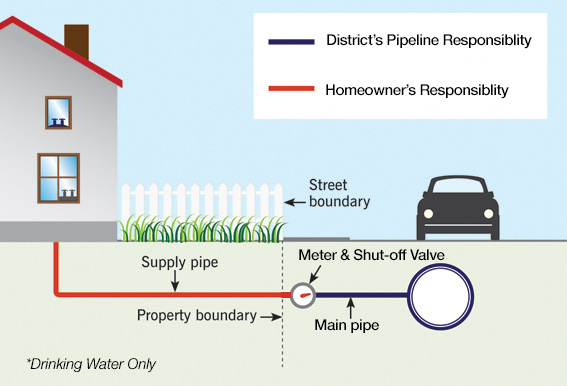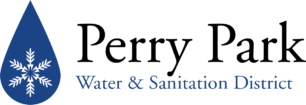Wastewater FAQs
Wastewater or sewage is the byproduct of many uses of water such as showering, dishwashing, laundry and flushing the toilet. After the water has been used, it enters the household’s wastewater pipeline and after it connects to the District’s main wastewater pipeline, the wastewater flows to one of Perry Park’s two, (Waucondah and Sageport), wastewater treatment plants.
Pollutants must be removed from the wastewater to help protect the environment and public health. When water is used in our community, the water becomes contaminated with human waste. If left untreated, these pollutants would negatively affect our health, water quality and environment.
It does not vary on bills because the District charges a flat bi-monthly fee that is the same for all residents.
Wastewater is collected throughout the District and sent to one of two existing wastewater treatment plants through a series of pipelines. The Waucondah Wastewater Treatment Plant provides treatment service for wastewater collected in West Perry Park. The Sageport Wastewater Treatment Plant provides treatment service for wastewater collected in East Perry Park.
The Waucondah Wastewater Treatment Plant (WWTP) discharges to Bear Creek, a tributary to West Plum Creek. The Sageport WWTP discharges to East Plum Creek.
With the wastewater pipeline, the property owner is responsible for the wastewater pipeline form their home until it connects to the main sewer pipeline. That is why it’s so important to NEVER put any oils, fats, or grease down the drain or flush anything but human waste and toilet paper down the toilet.

Run fresh water in all sinks to fill traps inside the house as they may have dried out. If this does not cure the problem, check the toilets and make sure they are firmly attached to the floor. The wax seal around the toilet may be compromised. If this does not resolve the issue, call a plumber immediately. Sewer gas may be harmful if breathed over a period of time.
A main line is that larger pipe usually in the street, which carries sewer to one of Perry Park’s Wastewater Treatment Plants for purification.
How to Avoid Sewer Backups
This includes what not to put down the drain.
You can avoid a backup by NOT putting any fats, oils, or grease down the drain and ensure that no objects other than toilet paper and human waste are being flushed down toilets. You might also want to contact a plumber to assess your pipeline and drains. Plumbers can install backflow prevention devices, clean out existing pipes, and video your sewage pipeline all the way to where it connects to the District’s main sewage pipeline.
It’s important to know that the sewer (wastewater) pipeline from the District’s main pipeline to and throughout the home is owned and maintained by the property owner. It’s at the point of connection (usually under the street) where the home pipeline connects to the wastewater main pipeline that the District takes over the responsibility for maintaining the wastewater pipeline.
Fats, oils, grease, meat drippings, wet wipes, lard, paint, medicine, salad dressing, solvents of any kind, sanitary pads, diapers, fertilizer, sanitary/wet wipes, cigarette butts should NEVER go down the drain or into the toilet. In other words, if it’s anything at all that is likely to contribute to your pipes getting clogged, put it in the trash, not down the drain.
If a backup occurs in your home, it is your responsibility to clean up any damage from the backup. That’s why it is so important to let everyone in your home know not to flush and put down the drain harmful items such as fats, oil, grease, wet wipes, feminine protection items, etc.
There are some insurance agencies that offer coverage for sewer and drain backups. Talk with your insurance agent to learn more.
- Check the toilets, sinks and drain pipes to clear any blockages to ensure that the water is not due to an internal plumbing problem. It’s important to know that a wastewater backup is contaminated and may contain a number of bacteria and viruses, which can affect your health.
- Try to carefully close as many drain openings as possible.
- Don’t run any more water, use the toilets or send any water down the drain as it will likely end up in your basement or lower levels of your home.
- Check with your neighbors to see if they are experiencing any backups. If they are, it is likely that it is a problem in the main sewage line. Contact the District immediately to report the problem.
- Call a plumber to assist with clearing the issue, closing any drains remaining open, and to assess your home’s internal issues.
- Contact your homeowner’s insurance to determine what coverage might be available.
Because of the size of the District’s collection system, one fifth of the sewer collection system is cleaned and inspected by video surveillance every year. The District uses high pressure water cleaning, tree root growth removal, and follows other points of inspection to ensure that our lines are clear of debris to keep the system running smoothly.
First, NEVER put them down the drain, toilet, or into the trash. To safely dispose of hazardous materials, call the Household Chemical Roundup Hotline for Douglas County 303-846-6249 or visit the Douglas County website for further information. There you can find out when they hold events where you can drop off hazardous household items.
Hydrant Flushing FAQs
It is when we literally flush the water mains (pipelines) to remove any settled particles (minerals like iron) from the system. This is accomplished by opening fire hydrants in a specific area, sending massive currents of water speeding through the pipes, scouring any minerals and other sediment from the pipes and out the hydrant.
Imagine driving down the road at about 1 or 2 miles an hour — the rate water normally moves through pipes in the winter when water demand is typically low. This slow movement allows sediment to build up over time, accumulating along the inside bottom of pipes. Our crews “pick up the speed of traffic” with flushing these water thoroughfares in order to help cleanse the pipes of sediment.
The water used with flushing is important for maintaining water quality and the integrity of the piping system. Flushing eliminates sediments that might otherwise build up, restrict water flow and cause corrosion. The unused water is actually a small price to pay compared to the costs and waste involved with poor water flow and pipe replacement.
Like us, most public water providers utilize some type of flushing program — it’s simply one of the best ways to maintain water quality and delivery reliability.
Yes, if a construction worker opens a fire hydrant too fast, it can cause the same sort of flushing effect in the surrounding area. If this happens and you experience any water discoloration, please try running your cold water for 5 minutes and if the problem persists for over 24-hours, please contact us.
Flushing is normally a springtime task, performed just as residents move outdoors, drawing more water to meet irrigation and recreational needs. Without flushing, these residents might find their in-home tap water discolored or water flow restricted. If, however, you are experiencing water discoloration, please let us know, as we will send out an operator to help solve the problem.
If your water does continues to run discolored, it points to the possibility of an unusually high volume of water demand and/or sediment in your area. Your call to us will help direct our efforts and allow us to correct any problems promptly. If your cold water runs clear, but the hot water remains discolored, you may have an entirely separate issue with your hot water heater.
If this occurs, we suggest draining and refilling the hot water tank. Make sure to do this cautiously, and follow all your manufacturer’s warnings to avoid getting burned, damaging your equipment or voiding your warranty.
Yes, our operators conduct ongoing water sample collections to verify water quality during the flushing process.
Please drive carefully and understand that our operators are maintaining your water system to help guarantee the delivery of quality water and to increase the life of our pipeline system. And, if you get the chance, thanking them is always nice, too.
